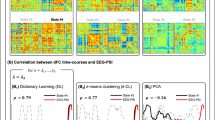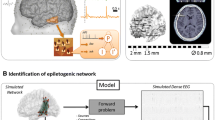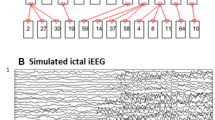Abstract
In this paper, a new method to track brain effective connectivity networks in the context of epilepsy is proposed. It relies on the combination of partial directed coherence with a constrained low-rank canonical polyadic tensor decomposition. With such combination being established, the most dominating directed graph structures underlying each time window of intracerebral electroencephalographic signals are optimally inferred. Obtained time and frequency signatures of inferred brain networks allow respectively to track the time evolution of these networks and to define frequency bands on which they are operating. Besides, the proposed method allows also to track brain connectivity networks through several epileptic seizures of the same patient. Understanding the most dominating directed graph structures over epileptic seizures and investigating their behavior over time and frequency plans are henceforth possible. Since only few but the the most important directed connections in the graph structure are of interest and also for a meaningful interpretation of obtained signatures to be guaranteed, the low-rank canonical polyadic tensor decomposition is prompted respectively by the sparsity and the non-negativity constraints on the tensor loading matrices. The main objective of this contribution is to propose a new way of tracking brain networks in the context of epileptic iEEG data by identifying the most dominant effective connectivity patterns underlying the observed iEEG signals at each time window. The performance of the proposed method is firstly evaluated on simulated data imitating brain activities and secondly on real intracerebral electroencephalographic signals obtained from an epileptic patient. The partial directed coherence-based tensor has been decomposed into space, time, and frequency signatures in accordance with the expected ground truth for each consecutive sequence of the simulated data. The method is also in accordance with the clinical expertise for iEEG epileptic signals, where the signatures were investigated through a simultaneous multi-seizure analysis.









Similar content being viewed by others
References
Akaike H (1969) Fitting autoregressive models for prediction. Ann Inst Stat Math 21(1):243–247
Astolfi L, Cincotti F, Mattia D, Salinari S, Bablioni C, Basilisco A, Rossini M, Ding L, Ni Y, He B, Marciani M, Bablioni F (2004) Estimation of the effective and functional human cortical connectivity with structural equation modeling and directed transfer function applied to high-resolution EEG. Magn Reson Imaging 22(10):1457–1470
Basser P, Mattiello J, Le Bihan D (1994) MR Diffusion tensor spectroscopy and imaging. Biophys J 66(1):259–267
Baccalá L, Sameshima K (2001) Partial directed coherence: a new concept in neural structure determination. Biol Cybern 84(6):463–474
Blinowska K (2011) Review of the methods of determination of directed connectivity from multichannel data. Med Biol Eng Comput 49(5):521–529
Bancaud P, Angelergues R, Bonis A, Bordas-Ferrer M, Bresson M, Buser P, Covello L, Morel P, Szikla G, Takeda A, Talairach J (1970) Functional stereotaxic exploration (SEEG) of epilepsy. Electroencephalographic Clin Neurophysiol 8(1):85–86
Bancaud J, Talairach J, Bonis A, Schaub G, Bordas-Ferer M (1965) La stéréo-électro-encéphalographie dans l’épilepsie : informations neurophysiopathologiques apportées par l’investigation fonctionnelle stéréotaxique. Edited by Masson
Boon P, Vonck K, De Reuck J, Caemaert J (2001) Vagus nerve stimulation for refractory epilepsy. Seizure 10(6):448–455
Boon P, Vandekerckhove T, Achten E, Thiery E, Goossens L, Vonck K, D’Have M, van Hoey G, Vanrumste B, Legros B, Defreyne L, De Reuck J (1999) Epilepsy surgery in Belgium, the experience in Gent. Acta Neurologica Belgica 99(4):256–265
Bohyd S, Parikh N, Chu E, Peleato B, Eckstein J (2010) Distributed opitmization and statistical learning via the alternating direction method of multipliers. Found Trends Mach Learn 3(1):1–122
Bro R (1997) PARAFAC, tutorial and applications. Chemom Intell Lab Syst 38:149–171
Bro R, Henk A, Kiers L (2003) A new efficient method for determining the number of components in PARAFAC models. Journal of Chemometrics 17(5):274–279
Bro R, Kjeldahl K, Smilde A, Kiers H (2003) Cross-validation of component models: a critical look at current methods. Anal Bioanal Chem 390(5):1241–1251
Carroll J, Chang J (1970) Analysis of individual differences in multidimensional scaling via an n-way generalization of “Eckart-Young” decomposition. Psychometrika 35:283–319
Yang C, Le Bouquin Jeannès R, Faucon G, Shu H (2019) Detecting information flow direction in multivariate linear and nonlinear models. Signal Process 93(1):304–312
Coloigner J, Karfoul A, Albera L, Common P (2014) Line search ans trust region strategies for canonical decomposition of semi- nonnegative semi-symetric 3rd order tensors. Linear Algebra Appl 450:334–374
Cong F, Lin Q, Kuang L, Gong X, Astikainen P, Ristaniemi T (2015) Tensor decomposition of EEG signals: a brief review. Computat Neurosci 248:59–69
De Herdt V, Boon P, Ceulemans B, Hauman H, Lagae L, Legros B, Sadzot B, Van Bogaert P, van Rijckevorsel K, Verhelst H, Vonck K (2007) Vagus nerve stimulation for refractory epilepsy: a Belgian multicenter study. Eur J Paediatr Neurol 11(5):261–269
Ding J, Tarokh V, Yang Y (2018) Model selection techniques: an overview. IEEE Signal Processing Magazine 35(6):16–34
Ding L (2009) Reconstructing cortical current density by exploring sparseness in the transform domain. Phys Med Biol 54(9):2683–2697
Fasoula A, Attal Y, Schwartz D (2013) Comparative performance evaluation of data-driven causality measures applies to brain networks. J Neurosci Methods 215(2):170–189
Fazel M (2002) Matrix rank minimization with applications. In PhD thesis, Stanford Univeristy
Friston K, Kahan J, Razi A, Stephan K, Sporns O (2014) On nodes and modes in resting state fMRI. NeuroImage 99:535–547
Friston K, Kahan J, Biswal B, Razi A (2014) A DCM for resting state fRMI. NeuroImage 94:396–407
Friston K (2011) Functional and effective connectivity: a review. Brain Connect 1(1):13–36
Gourevitch B, Le Bouquin Jeannès R, Faucon G (2006) Linear and non-linear causality between signals: methods, examples and neurophysiological applications. Biol Cybern 95(4):349–369
Granger C (1969) Investigating causal relations by econometric models and cross-spectral methods. Econometrica 37(3):424–438
Han X, Albera L, Kachenoura A, Senhadji L, Shu H (2017) Low rank canonical polyadic decomposition of tensors based on group sparsity. In: 25th European signal processing conference. Vol. 25, pp 668–672
Harshman R (1972) PARAFAC2: mathematical and technical notes. In: UCLA Working papers in phonetics, Vol. 22, University of California, Los Angeles
Hillard C, Lim L (2013) Most tensor problems are NP-hard. J ACM 60(6):39–45
Hitchcock F (1927) The expression of a tensor or a polyadic as sum of products. J Math Phys 6 (1-4):164–189
Karahan E, Rojas-López P, Bringas-Vega M, Valdés-Hernández P, Valdes-Sosa P (2015) Tensor analysis and fusion of multimodal brain images. Proc IEEE 103(9):1531–1559
Kolda T, Bader B (2009) Tensor decompositions and applications. SIAM Rev 51(3):455–500
Kritchman S, Nadler B (2008) Determining the number of components in a factor model from limited noisy data. Chemometr Intell Lab Syst 94(1):19–32
Kruskal J (1977) Three-way arrays: rank and uniqueness of trilinear decompositions, with application to arithmetic complexity and statistics. Linear Algebra Appl 18(12):95–138
De Lathauwer L (2008) Decompositions of a higher-order tensor in block terms - Part I: Lemmas for partitioned matrices. SIAM J Matrix Anal Appl 30(3):1022–1032
De Lathauwer L (2008) Decompositions of a higher-order tensor in block terms - Part II: Definitions and uniqueness. SIAM J Matrix Anal Appl 30(3):1033–1066
Liu K, da Costa J, Cheung So H, Huang L, Ye J (2016) Detection of number of components in CANDECOMP/PARAFAC models via minimum description length. Digit Signal Process 51:110–123
Minka T (2000) Automatic choice of dimensionality for PCA. In: 13th International conference on neural information processing systems, vol 13, pp 577–583
Miwakeichi F, Martinez-Montes E, Valdés-Sosa P, Nishiyama N, Mizuhara H, Yamaguchi Y (2004) Decomposing EEG data into space-time-frequency components using parallel factor analysis. NeuroImage 22(3):1035–1045
Mørup M, Hansen L, Herrmann C, Parnas J, Arnfred S (2006) Parallel factor analysis as an exploratory tool for wavelet transformed event-related eeg. NeuroImgae 29(3):938–947
Niesing J (1997) Simultaneous component and factor analysis methods for two or more groups: a comparative study. volume 2nd ed Leiden: The Netherlands, DSWO Press, Leiden University
Nunez P, Srinivasan R, Westdrop A, Wijesinghe R, Tucker D, Silberstein R, Cadusch P (1997) EEG Coherency: I: statistics, reference electrode, volume conduction, Laplacians, cortical imaging, and interpretation at multiple scales. Electroencephalography Clin Neurophysiol 103(5):449–515
Ozcaglar C, Shabbeer A, Vandenberg S, Yener B, Bennett K (2011) Sublineage structure analysis of Mycobacterium tuberculosis complex strains using multiple-biomarker tensors. BMC Genomics 12 (Suppl 2)S1:1–26
Pester B, Ligges C, Leistritz L, Witte H, Schiecke K (2015) Advanced insights into functional brain connectivity by combining tensor decomposition and partial directed coherence. PlOs one 10(6)
Petersen K, Pedersen M (2012) The matrix cookbook published by technical university of denmark. IMM Group:Intelligent Signal Processing
Priestley M (1981) Spectral analysis and time series, vol 1–2. Academic Press, London
Valdes-Sosa P, Roebroeck A, Daunizeau J, Friston K (2011) Effective connectivity: influence, causality and biophysical modeling. NeuroImage 58(2):339–361
Saito Y, Harashima H (1981) Tracking of information within multichannel EEG record - causal analysis in EEG. In: Recent advances in EEG and EMG data processing. Elsevier, Amsterdam, pp 133–146
Sameshima K, Baccalá L (1999) Using partial directed coherence to describe neuronal ensemble interactions. J Neurosci Methods 94(1):93–103
Schwartz G (1978) Estimating the dimension of a model. Ann Stat 6(2):461–464
Sidiropoulos N, Bro R, Giannakis G (2000) Parallel factor analysis in sensor array processing. IEEE Trans Signal Process 48(8):2377–2388
Sørensen M, De Lathauwer L (2013) Blind signal separation via tensor decomposition with vandermonde factor: canonical polyadic decomposition. IEEE Trans Signal Process 61(22):5507–5519
Sun F, Morell M (2014) The RNS System: responsive cortical stimulation for the treatment of refractory partial epilepsy. Expert Rev Med Devices 11(6):563–572
Taheri N, Han X, Karfoul A, Ansari K, Merlet I, Senhadji L, Albera L, Kachenoura A (2018) Brain source localization using constrained low rank canonical Polyadic decomposition. In: 52nd IEEE Asilomar conference on signals, systems and computers
Tucker L (1966) Some mathematical notes on three-mode factor analysis. Psychometrika 31 (3):279–311
Vonck K, Boon P, Claeys P, Dedeurwaerdere S, Achten R, van Roost D (2005) Long-term deep brain stimulation for refractory temporal lobe epilepsy. Epilepsia 46(Suppl. 5):98–99
Weiss M, Römer F, Haardt M, Jannek D, Husar P (2009) Multi-dimensional space-time-frequency component analysis of event related EEG data using closed-form PARAFAC. In: IEEE International conference on acoustics speech, and signal processing, pp 349–352
Wright S (1921) Correlation and causation. J Agr Res 20(7):557–585
Zhao Q, Zhou G, Zhang L, Cichocki A, Amari S (2015) Bayesian robust tensor factorization for incomplete multiway data. IEEE Trans Neural Netw Learng Syst 13(9):736–748
Acknowledgements
Authors would like to thank the CHU (Centre Hospitalier Universitaire), Rennes, France, for the iEEG dataset.
Author information
Authors and Affiliations
Corresponding author
Ethics declarations
Ethics approval
All experimental procedures have been conducted at the CHU (Centre Hospitalier Universitaire), Rennes, France, following the ethical and regulatory standards. The patient has signed a consent and has been informed that his iEEG data would be used for clinical research and might serve for publication.
Additional information
Publisher’s note
Springer Nature remains neutral with regard to jurisdictional claims in published maps and institutional affiliations.
Appendix A
Appendix A
1.1 A.1 Technical materials on the minimization of \(\boldsymbol {{\mathscr{L}}}_{1}\) defined in Eq. 14
As mentioned in Section 3.2.1, solving the minimization problem defined in Eq. 13 is possible by minimizing its associated augmented Lagrangian function \({\mathscr{L}}_{1}\) given by:
with respect to its variable matrices S, T, F. This minimization is possible by looking for the stationary points of \({\mathscr{L}}_{1}\) in these variable matrices, as shown hereafter. Note that according to Definition 3, we can write P(1) = S(F ⊙T)⊤, P(2) = T(S ⊙F)⊤, and P(3) = F(T ⊙S)⊤. For mathematical convenience, derivation of the update rules will be expressed in a vector form.
1.1.1 A.1.1 Update of S
The stationary point of \({\mathscr{L}}_{1}\) defined in Eq. 14 in S is computed by solving the equation \(\frac {\partial \boldsymbol {{\mathscr{L}}}_{1}}{\partial vec({\mathbf {S})}}=\mathbf {0}\). Then according to Eq. 24, we can write:
Now, based on the properties of matrix trace, Kronecker product [46], and [16], we obtain:
Then, by solving \(\frac {\partial \boldsymbol {{\mathscr{L}}}_{1}}{\partial vec({\mathbf {S})}}=\mathbf {0}\) with respect to vec(S), we get:
1.1.2 A.1.2 Update of T
Similarly, the stationary point of \({\mathscr{L}}_{1}\) defind in Eq. 14 in T is computed by solving the equation \(\frac {\partial \boldsymbol {{\mathscr{L}}}_{1}}{\partial vec({\mathbf {T})}}=\mathbf {0}\). Then according to Eq. 24, we can write:
Based also on the properties of matrix trace, Kronecker product [46], and [16], we obtain:
Then, by solving \(\frac {\partial {\mathscr{L}}_{1}}{\partial vec(\mathbf {S})}=\mathbf {0}\), we get:
1.1.3 A.1.3 Update of F
Similarly, the stationary point of \({\mathscr{L}}_{1}\) defined in Eq. 14 in F is computed by solving the equation \(\frac {\partial \boldsymbol {{\mathscr{L}}}_{1}}{\partial vec({\mathbf {F})}}=\mathbf {0}\). Then according to Eq. 24, we can write:
Based also on the properties of matrix trace, Kronecker product [46], and [16], we obtain:
Then, by solving \(\frac {\partial {\mathscr{L}}_{1}}{\partial vec(\mathbf {F})}=\mathbf {0}\), we get:
1.1.4 A.1.4 Update of Y
The update rule of the dual variable Y is given by:
where \({prox}_{\phi ,\frac {\delta }{\rho }}\) is a proximal operator dealing with non smooth function (here, \(\phi =\left \| . \right \|_{1} \)) initially proposed in [20] and \(\frac {\delta }{\rho }\) denotes the shrinking threshold.
1.1.5 A.1.5 Update of W
The update rule of the Lagrange multiplier W is given by:
1.2 A.2 Technical materials on the minimization of \(\boldsymbol {{\mathscr{L}}}_{2}\) defined in Eq. 17
As mentioned in Section 3.2.2, solving the minimization problem defined in Eq. 16 is possible by minimizing its associated augmented Lagrangian function \({\mathscr{L}}_{2}\) given by:
with respect to its variable matrices S, T, F, and C. This minimization is possible by looking for the stationary points of \({\mathscr{L}}_{2}\) in these variable matrices, as shown hereafter. Note that according to Definition 3, the unfolding matrices associated with the first, the second, the third, and the fourth direction of the 4rd-order tensor \(\boldsymbol {\mathcal {Q}}\) are given, respectively, by: Q(1) = S(C ⊙F ⊙T)⊤, Q(2) = T(S ⊙C ⊙F)⊤, Q(3) = F(T ⊙S ⊙C)⊤, and Q(4) = C(F ⊙T ⊙S)⊤. For mathematical convenience, derivation of the update rules will be expressed in a vector form.
1.2.1 A.2.1 Update of S
The stationary point of \({\mathscr{L}}_{2}\) defined in Eq. 17 in S is computed by solving the equation \(\frac {\partial \boldsymbol {{\mathscr{L}}}_{2}}{\partial vec({\mathbf {S})}}=\mathbf {0}\). Then according to Eq. 36, we can write:
Now based on the properties of matrix trace, Kronecker product [46], and [16], we obtain:
Then, by solving \(\frac {\partial \boldsymbol {{\mathscr{L}}}_{2}}{\partial vec({\mathbf {S})}}=\mathbf {0}\) with respect to vec(S), we get:
1.2.2 A.2.2 Update of T
Similarly, the stationary point of \({\mathscr{L}}_{2}\) defined in Eq. 17 in T is computed by solving the equation \(\frac {\partial \boldsymbol {{\mathscr{L}}}_{2}}{\partial vec({\mathbf {T})}}=\mathbf {0}\). Then according to Eq. 36, we can write:
Based also on the properties of matrix trace, Kronecker product [46], and [16], we obtain:
Then, by solving \(\frac {\partial {\mathscr{L}}_{2}}{\partial vec(\mathbf {S})}=\mathbf {0}\), we get:
1.2.3 A.2.3 Update of F
The stationary point of \({\mathscr{L}}_{2}\) defined in Eq. 17 in F is computed by solving the equation \(\frac {\partial \boldsymbol {{\mathscr{L}}}_{2}}{\partial vec({\mathbf {F})}}=\mathbf {0}\). Then, according to Eq. 24, we can write:
Based also on the properties of matrix trace, Kronecker product [46], and [16], we obtain:
Then, by solving \(\frac {\partial {\mathscr{L}}_{2}}{\partial vec(\mathbf {F})}=\mathbf {0}\), we get:
1.2.4 A.2.4 Update of C
Similarly, the stationary point of \({\mathscr{L}}_{2}\) defined in Eq. 17 in C is computed by solving the equation \(\frac {\partial \boldsymbol {{\mathscr{L}}}_{2}}{\partial vec({\mathbf {C})}}=\mathbf {0}\). Then according to Eq. 24, we can write:
Based also on the properties of matrix trace, Kronecker product [46], and [16], we obtain:
Then, by solving \(\frac {\partial {\mathscr{L}}_{2}}{\partial vec(\mathbf {C})}=\mathbf {0}\), we get:
1.2.5 A.2.5 Update of Y
The update rule of the dual variable Y is given by:
1.2.6 A.2.6 Update of W
The update rule of the Lagrange multiplier W is given by:
Rights and permissions
About this article
Cite this article
Chantal, PA., Karfoul, A., Nica, A. et al. Dynamic brain effective connectivity analysis based on low-rank canonical polyadic decomposition: application to epilepsy. Med Biol Eng Comput 59, 1081–1098 (2021). https://doi.org/10.1007/s11517-021-02325-x
Received:
Accepted:
Published:
Issue Date:
DOI: https://doi.org/10.1007/s11517-021-02325-x




